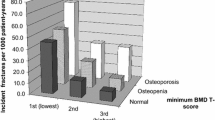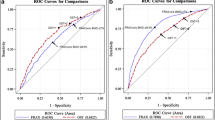Abstract:
In this study we report first the concordance and variation in diagnostic osteoporosis classification using multiple skeletal site measurements compared with the lumbar spine only; and secondly, at the lumbar spine, the variation and diagnostic osteoporosis reclassification using the lowest individual vertebra T-score compared with the L1–L4 mean T-score. One hundred and fifty early postmenopausal women were evaluated as part of the recruitment for a multicenter osteoporosis prevention study. Bone mineral density (BMD) was restricted such that no more than 10% of the subjects had a lumbar spine BMD below 0.8 g/cm2. Forty-seven per cent of the subjects were classified as having low bone mass (T-score ≤−1.0) at the lumbar spine, 63% at the mid-forearm, 39% at the distal forearm and 50% at the hip (p<0.05). The greatest proportion of subjects were categorized as osteoporotic at the lumbar spine, followed by the forearm and then the hip. Correlation between sites ranged from 0.57 to 0.60 (p<0.01). Eighty-one percent of the subjects had a significant difference between their highest and lowest individual lumbar vertebra T-score (defined as a difference outside the 90% confidence interval coefficient of variation T-score value). Using the lowest individual lumbar T-score, recategorized 33% of the subjects classified as osteopenic (based on the mean L1–L4 T-score) as osteoporotic, and 23% of those classified as normal as osteopenic (p<0.05). Of all four vertebrae, L2 had the highest T-score in 37.7% of the subjects (mean −0.3) and L4 the lowest in 61% (mean −1.5) (mean difference 1.2 units, 95% CI 0.7 to 1.7). The classification of osteoporosis varies according to skeletal site, with pronounced differences in the early menopausal population. T-scores are useful for characterizing subjects with the highest risk of osteoporosis but BMD and fracture risk must be recognized in a continuum. Individual T-scores of the lumbar vertebrae show wide variation in the absence of degenerative spinal disease or vertebral collapse and the use of the lowest, significantly different, individual lumbar vertebra T-score reclassified over half of the subjects in this study. This poses a great therapeutic dilemma in clinical practice, particularly if these fractures are at higher risk of future collapse.
Similar content being viewed by others
Author information
Authors and Affiliations
Additional information
Received: 9 November 1999 / Accepted: 27 April 2000
Rights and permissions
About this article
Cite this article
Sahota, O., Pearson, D., Cawte, S. et al. Site-Specific Variation in the Classification of Osteoporosis, and the Diagnostic Reclassification Using the Lowest Individual Lumbar Vertebra T-score Compared with the L1–L4 Mean, in Early Postmenopausal Women . Osteoporos Int 11, 852–857 (2000). https://doi.org/10.1007/s001980070044
Issue Date:
DOI: https://doi.org/10.1007/s001980070044




